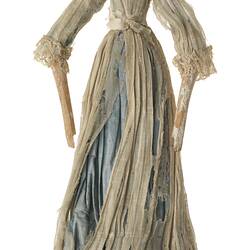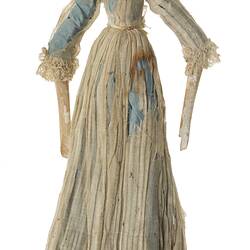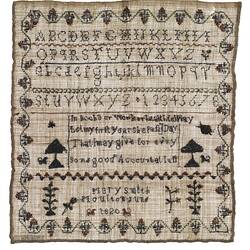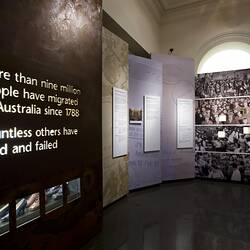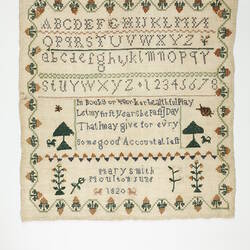Summary
Alternative Name(s): Penny Wooden Doll, Peg Wooden Doll
Made around 1805-1810 and brought to Australia by immigrant Mary Spencer (nee Smith, born 1808) from England in 1842. Mary travelled with her by bullock cart to Iron Bark and Mt Abundance. Mary gave the doll and a sampler to her daughter Manyanna, who cherished them all her long life. When she died in 1926 various family members cared for them until they were acquired by the Museum in 1988.
These types of dolls, according to the Collector's Book of Dolls, are known as 'peg woodens', 'penny woodens', 'Nurnberg filllies' or 'Dutch' dolls, although actually the style is characteristically from Austria. At the beginning of the 19th century the doll typically had an elongated body and jointed hips and knees.
Physical Description
Elongated body, spoon-like gesso-covered hands, jointed hips and knees, gesso-covered lower legs and pink, painted slippers. Head carving and body is skillfully done, face is well painted. Small hole on top of head may originally have held a comb. Still in original clothes.
Significance
This wooden doll which was made circa 1805-1810 and brought to Australia by immigrant Mary Spencer (nee Smith) from England in the early 19th century is one of the oldest known provenanced dolls in Australia.
More Information
-
Collecting Areas
-
Acquisition Information
Purchase
-
Place & Date Made
England, Great Britain, 1805-1810
Approximate date(s). -
User
Mary Spencer, New South Wales, Australia, 1842
Mary brought the doll with her when she migrated from England. -
Classification
-
Category
-
Discipline
-
Type of item
-
overall dimensions
201 mm (Width), 402 mm (Height)
-
Exhibition Collection Management
401.5 mm (Length), 201 mm (Width)
-
Dimensions
165 mm (Width), 40 mm (Depth), 420 mm (Height)
Measurement From Conservation.
-
References
The Smith/Spencer family archives are held at the Oxley Libary, Brisbane; other family memorabilia may have been donated to the Queensland Museum. Susanna de Vries has a chapter on Mary Spencer's daughter in her book Females on the Fatal Shore (2009) but with no reference to the archives in Queensland or the MV holdings.
-
Keywords

